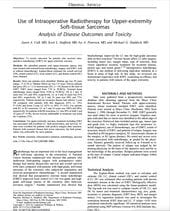OVERVIEW
To review outcomes for patients who received intra-operative radiotherapy (IORT) for upper-extremity sarcoma.
METHODS AND MATERIALS
We identified patients with upper-extremity tumors who were treated with external beam radiotherapy, surgery, and IORT, with or without chemotherapy. Kaplan-Meier estimates for overall survival (OS), central control (CC), local control (LC), and distant control (DC) were obtained.
RESULTS
Sixty-one patients were identified. Median age was 50 years (range, 13 to 95 y). Median follow-up was 5.9 years. Eleven patients had gross (R2; n = 1) or microscopic (R1; n = 10) disease at the time of IORT. IORT doses ranged from 7.50 to 20.00 Gy. External beam radiotherapy doses ranged from 19.80 to 54.00 Gy. OS at 5 and 10 years was 72% and 58%, respectively. LC at 5 and 10 years was 91%and 88%, respectively. DC at 5 and 10 years was 80% and 77%, respectively. Patients treated for recurrent disease had inferior 5-year OS compared with patients with first diagnoses (63% vs. 74%; P = 0.02) and lower 5-year LC (67% vs. 94%; P < 0.01). For patients with R1 or R2 resections, LC at 5 and 10 years was 100% and 86%, respectively; for patients with R0 resections, LC was 89% at both 5 and 10 years (P = 0.98). Severe toxicity attributable to treatment was noted for 4 patients (7%).
CONCLUSION
For upper-extremity sarcoma, treatment including IORT was associated with excellent LC, limb preservation, and survival. LC rates were excellent for patients with positive margins after resection. Patients with recurrent disease had worse outcomes, but limb preservation was achievable for most patients.
